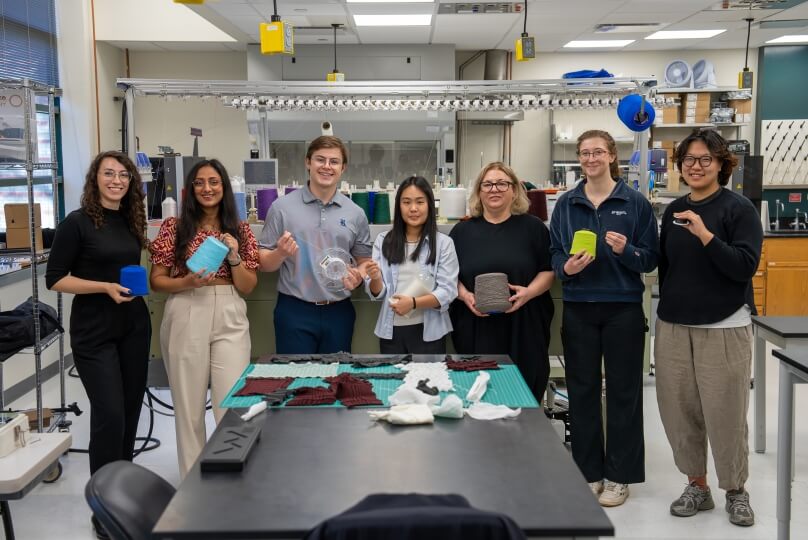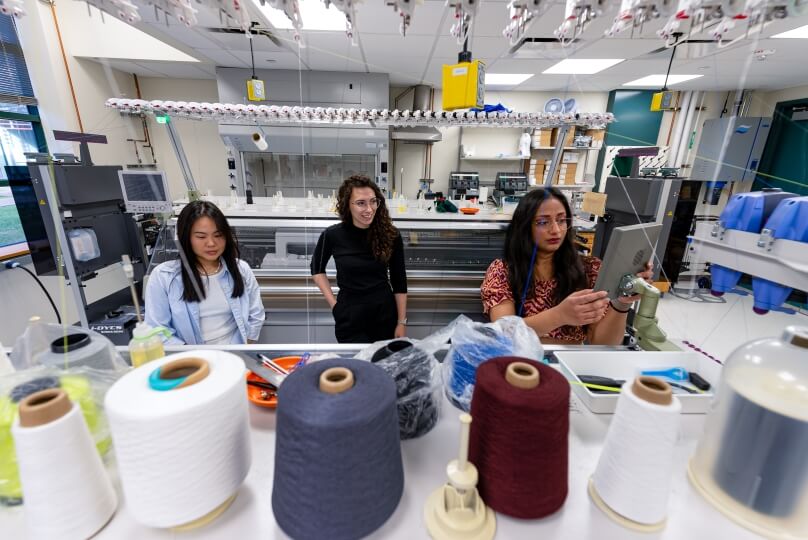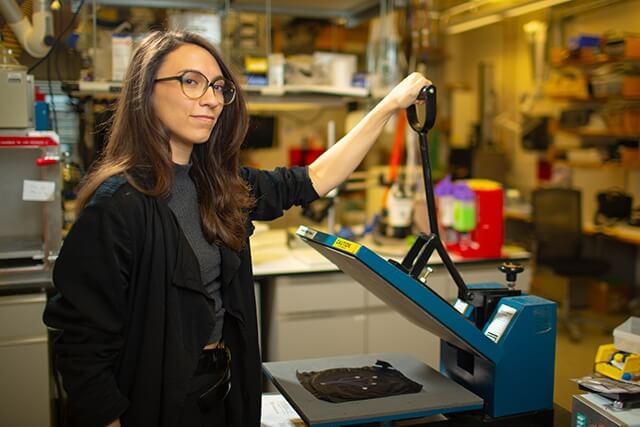SEAS alumna Vanessa Sanchez, left, with her texlab students at Rice University (Jorge Vidal/Rice University)
Vanessa Sanchez came to the Harvard John A. Paulson School of Engineering and Applied Sciences (SEAS) for its non-traditional approach to engineering education, but she's always looked for non-traditional paths. She began as an apparel design student at the Fashion Institute of Technology in New York, only to discover that what she really loved about fashion was the materials science. That brought her to the fiber sciences program at Cornell, before coming here. Once here, she was exposed to entirely new areas of research as a materials science and mechanical engineering Ph.D. student.
“I did not know anything about soft robotics when I started at Harvard,” Sanchez said. “What drew me to SEAS was that it was non-traditional. It didn’t have departments, so I could work across areas on projects and challenges that I thought were really interesting, even if they transcended from materials to robotics. I’d work beside people who were working on totally different projects, like implantable devices, exosuits, even robobees. I really liked that, and it felt really unique.”
Sanchez worked with three different labs at SEAS, and draws on all three of them as principal investigator of her own lab at Rice University, where she’s in her first year as assistant professor of mechanical engineering. Her group is called texlab, which has three meanings: TEX stands for “theory to execution,” a reference to the lab’s goals of producing experimental materials that could be applied in the real world; the lab frequently works with textiles and textile machines in its robotics and wearable devices research; and the lab is at Rice, which is in Houston, Texas.
“My lab works between manufacturing, materials and robotics,” Sanchez said. “Understanding the intersections between different fields is something central to my work. I don’t think I’d be here without my Harvard experience. It really changed the way I think about science, and what problems I want to work on.”
Vanessa Sanchez, middle, works with students in her lab at Rice University (Jorge Vidal/Rice University)
Rice first offered an appointment to Sanchez in 2023, where she delayed joining the school until this past fall so she could complete her postdoctoral work at Stanford. Her lab there focused on wearable devices and materials inspired by human tissue, and from there she spent six months doing additional wearable device research at Meta’s Reality Labs.
“A colleague reached out and shared an odd, shorter-term project at Meta that needed someone with very specific expertise,” she said. “I fit the skillset, and I was curious about what they were doing there and gain some industry experience that I might be able to pass on to my future students. That colleague was in one of my Harvard labs with me.”
When it became time to get her own lab off the ground Sanchez drew on her experiences in all three SEAS labs: her master’s research in Conor Walsh’s Harvard Biodesign Lab and the George Whitesides Research Group, and her research in the Harvard Microrobotics Lab with Ph.D. advisor Robert Wood, Harry Lewis and Marlyn McGrath Professor of Engineering and Applied Sciences. Each lab experience was unique, and each taught her something about how to run a successful lab.
“That made me feel more empowered to pursue my own style of advising instead of just emulating one I previously experienced,” she said. “A big thing I learned at Harvard was how you don’t just think about the project you’re working on, but a larger vision. That was instilled in me a lot in the labs I was in: what are the grand challenges, what is your vision, and how can you communicate it to other people. Establishing a lab culture and being very intentional about it is something that’s so important as the people are the most important part. It’ll make your lab run more smoothly. It’ll make people excited and want to help each other out and share their expertise and knowledge.”
Sanchez also taught one undergraduate class section on mechanical engineering design tools in the fall, and this spring is using her department’s teaching release option to focus on ramping up texlab. That’s meant everything from the logistics of bringing in equipment, to applying for research grants, to making sure her first cohort of three Ph.D. students have what they need to do their own research.
“Every institution has its own style, so just learning the institutional culture at Rice takes some time,” she said. “We have very large equipment, some of which is from overseas, so I’ve had to figure out the logistics of actually getting it into the lab. It’s chaotic, but exciting. We have one of only two of the newest Japanese knitting machines in the U.S., and I also have a punch-card knitting machine from the 1970s, and a hand crank machine from the 1940s, all in the same lab.”
Vanessa Sanchez, S.M. '20, Ph.D. '22 (Wyss Institute at Harvard University)
Combining older and cutting-edge technology is nothing new for Sanchez. In Wood’s lab, she developed methods to effectively 3D print soft, knitted robots, collaborating with CMU. The project began on decades-old knitting equipment before moving to new machines and required the development of new strategies that could control the production of robots that actuate with desired motion profiles.
“The old machines are good for understanding mechanical design in a very manual, visual way,” she said. “You could try something out on a manual machine, then learn if it’s possible and how you can build on that with a modern machine.”
Texlab currently consists of Sanchez, her three Ph.D. students, two staff members and one postdoctoral researcher. The lab also recently held an open house for undergraduate researchers. As she continues to build this new lab from scratch at Rice, Sanchez continues to consult with both her former teachers and classmates.
“I got to work on projects and interact with people who really changed my way of thinking for the better at Harvard,” she said. “I think I’d be such a different scientist if I hadn’t gone there.”
Press Contact
Matt Goisman | mgoisman@g.harvard.edu


